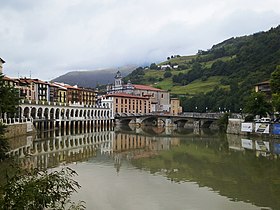Battle of Tolosa (1813)
| Battle of Tolosa (1813) | |||||||
|---|---|---|---|---|---|---|---|
| Part of the Peninsular War | |||||||
 Tolosa lies in the deep valley of the Oria River. |
|||||||
|
|||||||
| Belligerents | |||||||
|
|
|
||||||
| Commanders and leaders | |||||||
|
|
|
||||||
| Strength | |||||||
|
|
|
||||||
| Casualties and losses | |||||||
| 24 June: 193 26 June: 619 |
24 June: 300 26 June: 400+ |
||||||
The Battle of Tolosa (26 June 1813) saw a British-Portuguese-Spanish column led by Thomas Graham attempt to cut off a retreating Franco-Italian force under Maximilien Sébastien Foy. Assisted by Antoine Louis Popon de Maucune's division, which fortuitously appeared, the French parried Graham's initial attacks then slipped away when threatened with envelopment. The town of Tolosa is located about 20 kilometres (12 mi) south of San Sebastián. The clash occurred during the Peninsular War, part of the wider Napoleonic Wars.
In the late spring of 1813, the Allied army of Arthur Wellesley, Marquess of Wellington launched a powerful offensive designed to drive King Joseph Bonaparte's Imperial French army from Spain. On 21 June, Wellington's army inflicted a decisive defeat on Joseph's troops at the Battle of Vitoria. As the defeated French armies withdrew toward the Pyrenees, Wellington tried to intercept Foy's column in the north and Bertrand Clausel's forces in the south. Neither Foy nor Clausel had fought at Vitoria. Graham caught up with Foy's column, but after some fighting, the French got away. Clausel also managed to avoid being cut off, but except for the Sieges of San Sebastian and Pamplona, northern Spain was soon free of French occupation. The next pitched battle was the Battle of the Pyrenees which began on 25 July.
In the spring of 1813, the French were capable of deploying 95,000 troops to defend Spain against Wellington's army. There were 42,000 men in Honoré Charles Reille's Army of Portugal, 36,000 in Honoré Théodore Maxime Gazan de la Peyrière's Army of the South and 17,000 in Jean-Baptiste Drouet, Comte d'Erlon's Army of the Center. However, Emperor Napoleon ordered Reille's six divisions to hunt down Spanish guerillas in northern Spain. This operation left King Joseph Bonaparte and Marshal Jean-Baptiste Jourdan with only 33,000 infantry and 9,000 cavalry and 100 guns. When Joseph protested, his concerns were brushed aside. In fact, Wellington advanced with 52,000 British, 28,000 Portuguese and 25,000 Spanish soldiers. Meanwhile, the Army of the North counted 40,000 troops but most of these were tied up in garrisons so that only 10,000 were available for field operations. On 14 January, Napoleon ordered Clausel to replace Joseph Caffarelli in command of the Army of the North. The new leader was expected to suppress the guerillas of northern Spain and clear the main highway between France and Spain.
...
Wikipedia
